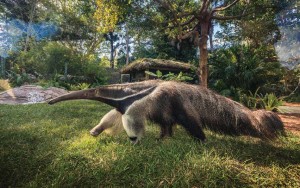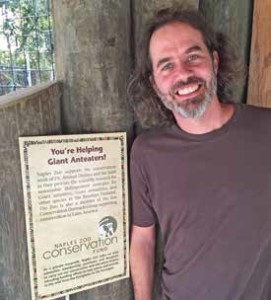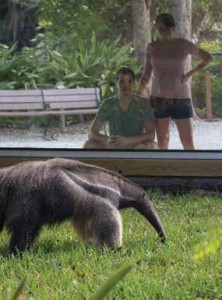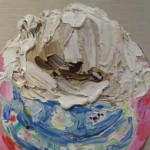Why The Long Face
A giant faces new threats, but also has new allies
 by Tim L. Tetzlaff
by Tim L. Tetzlaff
Naples Zoo Director of Conservation
Meet the giant anteater. A creature with a hopelessly long nose. A mouth lacking all teeth. A broad, bushy tail that looks like it’s made of old corn brooms. Hearing that barely does the job. Eyesight that would keep us in a perennial squint. This assemblage of body parts is a seven-foot-long giant that eats miniature food. And they must travel long distances to do it by walking on their knuckles. This bizarre marvel of the animal kingdom has overcome almost every obstacle to survival – except the modern car.
While anteaters do lack some of the more common qualities of familiar animals, they do have a few surprises up their long nose. For starters, they’ve got camouflage that rivals an Army sniper in a ghillie suit. In the tropical forests and grasslands of Central and South America, the giant anteater has been described as the bush that walks. And for the 16 hours a day it can rest cloaked beneath the blanket of its tail, you’d be easily forgiven for accidentally stepping on one thinking it was leaf litter.

DR. ARNAUD DESBIEZ AND HIS TEAM
And speaking of something up their nose, that’s home to a two-foot-long tongue and a keen sense of smell. These are their secret weapons for finding food. Although many tall termite mounds can be readily spotted, anteaters prefer the lower mounds and use that super sniffer to find them.
But termite mounds are not soft sand that fall apart upon touch. Termite mounds are hardened shells capable of withstanding heavy rains and supporting the weight of large animals that use them as look out points. To get inside, anteaters unveil their concealed weapons. The reason they walk on their knuckles is revealed by a closer look at their feet where anteaters hide powerful 10 cm (4 in) claws. Cement-hard mounds are no match for these piercing tools. And they’re great defense as well. Even hungry jaguars have paid with their lives by underestimating the deadly force an anteater can unleash with these hooks.
Once the mound is breached, anteaters claw inside allowing their long snout to shoot out a saliva-covered tongue over two and half times a second to rapidly catch up insects. But they only have about a minute before soldier insects mount a full defense and repel the attack. In an odd bit of symbiosis, this not only saves the mound from destruction, but also insures anteaters have a place for a future meal. It also means a lot of walking since anteaters need to consume over 30,000 ants and termites each day – a feat that has been estimated to require visiting dozens of mounds an hour during their active feeding times.

DR. ARNAUD DESBIEZ
And that walking is part of their problem. In rapidly developing areas like Brazil’s Cerrado savanna, the longer you walk, the more roads you must cross. Predictably, dull hearing and poor eyesight is a deadly combination against fast moving vehicles. Loss of good places for anteaters to live is a grave concern. It is now considered the most threatened mammal in Central America and is likely already extinct in four countries on the isthmus. But even in areas where habitat exists, a road across an anteater’s range can be lethal.
To analyze this impact, award-winning researcher Dr. Arnaud Desbiez and his team conducted a roadkill study in the Cerrado. The results were stark. Monitoring about 600 miles of paved road every two weeks over a one-year period, the team documented 136 giant anteaters killed by vehicles. By some counts, that’s potentially more dead anteaters per road mile than we hit deer in America.
With other South American species like the tapir, research has lead to decreased roadkills. In hopes of replicating these successes Naples Zoo has been directly funding Desbiez’s work over recent years including using GPS harnesses to better understand their movements to discern patterns that may help in saving them.
In fact, grants from various zoos like ours have made up 80 percent of funding for Desbiez’s efforts. But this help goes beyond finances. As he says, “Whether it is to review an anesthetic protocol, discuss a particular behavior, review a paper we wrote, give advice on equipment or even help develop a fundraising strategy, advice from zoo professionals is very much appreciated and most often fundamental. It is amazing how generous people working in zoos are with their time and expertise.”
 Desbiez’s efforts are just one of many programs supported by a consortium known as the Zoo Conservation Outreach Group (ZCOG). Naples Zoo is one of its key supporters and I recently became Vice-Chair of this non-governmental organization dedicated to conservation in Central and South America. Beyond fieldwork, ZCOG provides international scholarships for wildlife professionals in the New World to attend training through the Association of Zoos and Aquariums. Under the category of teaching a person to fish, Naples Zoo now wholly funds the Caribbean Conservation Training Scholarship to build capacity in colleagues from the Caribbean Basin.
Desbiez’s efforts are just one of many programs supported by a consortium known as the Zoo Conservation Outreach Group (ZCOG). Naples Zoo is one of its key supporters and I recently became Vice-Chair of this non-governmental organization dedicated to conservation in Central and South America. Beyond fieldwork, ZCOG provides international scholarships for wildlife professionals in the New World to attend training through the Association of Zoos and Aquariums. Under the category of teaching a person to fish, Naples Zoo now wholly funds the Caribbean Conservation Training Scholarship to build capacity in colleagues from the Caribbean Basin.
These efforts and many others have earned your zoo recognition as one of the top supporters of field conservation as determined by the Association of Zoos and Aquariums. Best of all, you are part of these efforts whenever you purchase a daily ticket or membership to our private, nonprofit organization. And that means a better future for giant anteaters and many more of our world’s miraculous animals.
Far from the simple menageries of past, today’s nationally accredited zoos are centers of learning and natural crossroads for biologists, educators, environmental scientists, and researchers – as well as for students, conservationists, and all animal lovers. Naples Zoo at Caribbean Gardens is a trusted, private 501(c)(3) nonprofit serving wildlife and families here and around the world. More
information at www.napleszoo.org.


Leave a Reply
Want to join the discussion?Feel free to contribute!